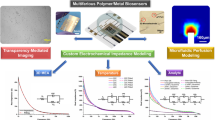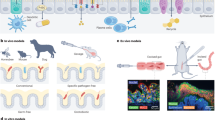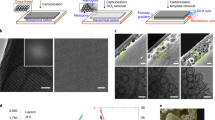Abstract
Organs-on-chips have emerged as viable platforms for drug screening and personalized medicine. While a wide variety of human organ-on-a-chip models have been developed, rarely have there been reports on the inclusion of sensors, which are critical in continually measuring the microenvironmental parameters and the dynamic responses of the microtissues to pharmaceutical compounds over extended periods of time. In addition, automation capacity is strongly desired for chronological monitoring. To overcome this major hurdle, in this protocol we detail the fabrication of electrochemical affinity-based biosensors and their integration with microfluidic chips to achieve in-line microelectrode functionalization, biomarker detection and sensor regeneration, allowing continual, in situ and noninvasive quantification of soluble biomarkers on organ-on-a-chip platforms. This platform is almost universal and can be applied to in-line detection of a majority of biomarkers, can be connected with existing organ-on-a-chip devices and can be multiplexed for simultaneous measurement of multiple biomarkers. Specifically, this protocol begins with fabrication of the electrochemically competent microelectrodes and the associated microfluidic devices (~3 d). The integration of electrochemical biosensors with the chips and their further combination with the rest of the platform takes ~3 h. The functionalization and regeneration of the microelectrodes are subsequently described, which require ~7 h in total. One cycle of sampling and detection of up to three biomarkers accounts for ~1 h.
This is a preview of subscription content, access via your institution
Access options
Access Nature and 54 other Nature Portfolio journals
Get Nature+, our best-value online-access subscription
$32.99 / 30 days
cancel any time
Subscribe to this journal
Receive 12 print issues and online access
$259.00 per year
only $21.58 per issue
Buy this article
- Purchase on SpringerLink
- Instant access to full article PDF
Prices may be subject to local taxes which are calculated during checkout





Similar content being viewed by others
Data availability
Most data associated with this protocol can be found in previous publications13,21,22. Additional datasets that support this protocol are available from the corresponding authors upon reasonable request. All requests for raw and analyzed data and materials will be promptly reviewed by the Brigham and Women’s Hospital to verify whether the request is subject to any intellectual property or confidentiality obligations. Any data and materials that can be shared will be released via a Material Transfer Agreement.
Code availability
The MATLAB codes can be accessed through previous publications13,21,22 and the Zhang Lab website (Electrochemical Biosensing; https://shrikezhang.com/publications/opensource). The running of these codes is standardized, and additional instructions can be found in the readme file in the package.
References
Ahadian, S. et al. Organ-on-a-chip platforms: a convergence of advanced materials, cells, and microscale technologies. Adv. Healthc. Mater. https://doi.org/10.1002/adhm.201800734 (2018).
Wang, Y. I., Carmona, C., Hickman, J. J. & Shuler, M. L. Multiorgan microphysiological systems for drug development: strategies, advances, and challenges. Adv. Healthc. Mater. 7, 1701000 (2018).
Ronaldson-Bouchard, K. & Vunjak-Novakovic, G. Organs-on-a-chip: a fast track for engineered human tissues in drug development. Cell Stem Cell 22, 310–324 (2018).
Zhang, Y. S. et al. From cardiac tissue engineering to heart-on-a-chip: beating challenges. Biomed. Mater. 10, 034006 (2015).
Arrigoni, C., Lopa, S., Candrian, C. & Moretti, M. Organs-on-a-chip as model systems for multifactorial musculoskeletal diseases. Curr. Opin. Biotechnol. 63, 79–88 (2020).
Mobini, S., Song, Y. H., McCrary, M. W. & Schmidt, C. E. Advances in ex vivo models and lab-on-a-chip devices for neural tissue engineering. Biomaterials 198, 146–166 (2019).
Bein, A. et al. Microfluidic organ-on-a-chip models of human intestine. Cell. Mol. Gastroenterol. Hepatol. 5, 659–668 (2018).
Ashammakhi, N., Wesseling-Perry, K., Hasan, A., Elkhammas, E. & Zhang, Y. S. Kidney-on-a-chip: untapped opportunities. Kidney Int. 94, 1073–1086 (2018).
Conant, G. et al. High-content assessment of cardiac function using heart-on-a-chip devices as drug screening model. Stem Cell Rev. Rep. 13, 335–346 (2017).
Ribas, J. et al. Biomechanical strain exacerbates inflammation on a progeria-on-a-chip model. Small https://doi.org/10.1002/smll.201603737 (2017).
Zhang, Y. S., Zhang, Y. N. & Zhang, W. Cancer-on-a-chip systems at the frontier of nanomedicine. Drug Discov. Today 22, 1392–1399 (2017).
Skardal, A., Shupe, T. & Atala, A. Organoid-on-a-chip and body-on-a-chip systems for drug screening and disease modeling. Drug Discov. Today 21, 1399–1411 (2016).
Zhang, Y. S. et al. Multisensor-integrated organs-on-chips platform for automated and continual in situ monitoring of organoid behaviors. Proc. Natl Acad. Sci. USA 114, E2293–E2302 (2017).
Riahi, R. et al. Automated microfluidic platform of bead-based electrochemical immunosensor integrated with bioreactor for continual monitoring of cell secreted biomarkers. Sci. Rep. 6, 24598 (2016).
Skardal, A. et al. Multi-tissue interactions in an integrated three-tissue organ-on-a-chip platform. Sci. Rep. 7, 8837 (2017).
Skardal, A. et al. Drug compound screening in single and integrated multi-organoid body-on-a-chip systems. Biofabrication 12, 025017 (2020).
Edington, C. D. et al. Interconnected microphysiological systems for quantitative biology and pharmacology studies. Sci. Rep. 8, 4530 (2018).
Oleaga, C. et al. Multi-organ toxicity demonstration in a functional human in vitro system composed of four organs. Sci. Rep. 6, 20030 (2016).
Novak, R. et al. Robotic fluidic coupling and interrogation of multiple vascularized organ chips. Nat. Biomed. Eng. 4, 407–420 (2020).
Kratz, S. R. A., Holl, G., Schuller, P., Ertl, P. & Rothbauer, M. Latest trends in biosensing for microphysiological organs-on-a-chip and body-on-a-chip systems. Biosensors (Basel) https://doi.org/10.3390/bios9030110 (2019).
Shin, S. R. et al. Label-free and regenerative electrochemical microfluidic biosensors for continual monitoring of cell secretomes. Adv. Sci. (Weinh.) 4, 1600522 (2017).
Shin, S. R. et al. Aptamer-based microfluidic electrochemical biosensor for monitoring cell-secreted trace cardiac biomarkers. Anal. Chem. 88, 10019–10027 (2016).
Zhang, Y. S. et al. Google Glass-directed monitoring and control of microfluidic biosensors and actuators. Sci. Rep. 6, 22237 (2016).
Rusling, J. F. Multiplexed electrochemical protein detection and translation to personalized cancer diagnostics. Anal. Chem. 85, 5304–5310 (2013).
Goode, J. A., Rushworth, J. V. H. & Millner, P. A. Biosensor regeneration: a review of common techniques and outcomes. Langmuir 31, 6267–6276 (2015).
Rajan, S. A. P. et al. Probing prodrug metabolism and reciprocal toxicity with an integrated and humanized multi-tissue organ-on-a-chip platform. Acta Biomater. 106, 124–135 (2020).
Aleman, J. & Skardal, A. A multi-site metastasis-on-a-chip microphysiological system for assessing metastatic preference of cancer cells. Biotechnol. Bioeng. 116, 936–944 (2019).
Aleman, J. et al. Deconstructed microfluidic bone marrow on-a-chip to study normal and malignant hemopoietic cell-niche interactions. Small 15, e1902971 (2019).
Soucy, J. R., Bindas, A. J., Koppes, A. N. & Koppes, R. A. Instrumented microphysiological systems for real-time measurement and manipulation of cellular electrochemical processes. IScience 21, 521–548 (2019).
Pourmand, A. et al. Fabrication of whole-thermoplastic normally closed microvalve, micro check valve, and micropump. Sens. Actuat. B-Chem. 262, 625–636 (2018).
Shaegh, S. A. M. et al. Rapid prototyping of whole-thermoplastic microfluidics with built-in microvalves using laser ablation and thermal fusion bonding. Sens. Actuat. B-Chem. 255, 100–109 (2018).
Lee, Y.-S., Bhattacharjee, N. & Folch, A. 3D-printed Quake-style microvalves and micropumps. Lab Chip 18, 1207–1214 (2018).
Ellington, A. D. & Szostak, J. W. In vitro selection of RNA molecules that bind specific ligands. Nature 346, 818–822 (1990).
Dauphin-Ducharme, P., Arroyo-Currás, N. Y. & Plaxco, K. W. High-precision electrochemical measurements of the guanine-, mismatch-, and length-dependence of electron transfer from electrode-bound DNA are consistent with a contact-mediated mechanism. J. Am. Chem. Soc. 141, 1304–1311 (2019).
Kurnik, M., Pang, E. Z. & Plaxco, K. W. An electrochemical biosensor architecture based on protein folding supports direct real‐time measurements in whole blood. Angew. Chem. (2020).
Kang, E., Shin, S.-J., Lee, K. H. & Lee, S.-H. Novel PDMS cylindrical channels that generate coaxial flow, and application to fabrication of microfibers and particles. Lab Chip 10, 1856–1861 (2010).
Kang, E. et al. Digitally tunable physicochemical coding of material composition and topography in continuous microfibres. Nat. Mater. 10, 877–883 (2011).
MacDonald, M. A. & Andreas, H. A. Method for equivalent circuit determination for electrochemical impedance spectroscopy data of protein adsorption on solid surfaces. Electrochim. Acta 129, 290–299 (2014).
McCauley, T. G., Hamaguchi, N. & Stanton, M. Aptamer-based biosensor arrays for detection and quantification of biological macromolecules. Anal. Biochem. 319, 244–250 (2003).
Kara, P. et al. Aptamers based electrochemical biosensor for protein detection using carbon nanotubes platforms. Biosens. Bioelectron. 26, 1715–1718 (2010).
Acknowledgements
The authors acknowledge support by the National Institutes of Health (R00CA201603 and UG3TR003274) and the Brigham Research Institute. This work was also partially sponsored by the Office of the Secretary of Defense through the Advanced Regenerative Manufacturing Institute (ARMI|BioFabUSA) and was accomplished under Agreement Number W911NF-17-3-003. The views and conclusions contained in this document are those of the authors and should not be interpreted as representing the official policies, either expressed or implied, of the Office of the Secretary of Defense or the US Government. The US Government is authorized to reproduce and distribute reprints for government purposes notwithstanding any copyright notation here. T.K. is grateful to the Swiss National Science Foundation for the Postdoc Mobility fellowship (no. P400PM_180788/1).
Author information
Authors and Affiliations
Contributions
Y.S.Z. and S.R.S. conceived the project; J.A., T.K. and Y.S.Z. drafted the initial manuscript; L.S.M. created the figures; J.A., T.K., S.R.S. and Y.S.Z. revised the manuscript. All authors approved the manuscript.
Corresponding authors
Ethics declarations
Competing interests
The authors declare no competing interests.
Additional information
Peer review information Nature Protocols thanks Xingyu Jiang, Arben Merkoçi and José Pingarrón for their contribution to the peer review of this work.
Publisher’s note Springer Nature remains neutral with regard to jurisdictional claims in published maps and institutional affiliations.
Related links
Key reference using this protocol:
Zhang, Y. S. et al. Proc. Natl Acad. Sci. USA 114, E2293–E2302 (2017): https://doi.org/10.1073/pnas.1612906114
Shin, S. R. et al. Adv. Sci. (Weinh) 4, 1600522 (2017): https://doi.org/10.1002/advs.201600522
Shin, S. R. et al. Anal. Chem. 88, 10019–10027 (2016): https://doi.org/10.1021/acs.analchem.6b02028
Supplementary information
Supplementary Data 1
AutoCAD designs of breadboard and EC sensing chip with regular, simplified and multiplexed channel configurations
Rights and permissions
About this article
Cite this article
Aleman, J., Kilic, T., Mille, L.S. et al. Microfluidic integration of regeneratable electrochemical affinity-based biosensors for continual monitoring of organ-on-a-chip devices. Nat Protoc 16, 2564–2593 (2021). https://doi.org/10.1038/s41596-021-00511-7
Received:
Accepted:
Published:
Issue date:
DOI: https://doi.org/10.1038/s41596-021-00511-7
This article is cited by
-
Advances in microfluidic chip technology for cell analysis
Analytical Sciences (2025)
-
Microfluidic Systems: Recent Advances in Chronic Disease Diagnosis and Their Therapeutic Management
Indian Journal of Microbiology (2025)
-
Wearable Devices for Biofluid Monitoring in a Body: from Lab to Commercialization
Korean Journal of Chemical Engineering (2025)
-
Bio-inspired biorthogonal compartmental microparticles for tumor chemotherapy and photothermal therapy
Journal of Nanobiotechnology (2024)
-
A drug-mediated organic electrochemical transistor for robustly reusable biosensors
Nature Materials (2024)



